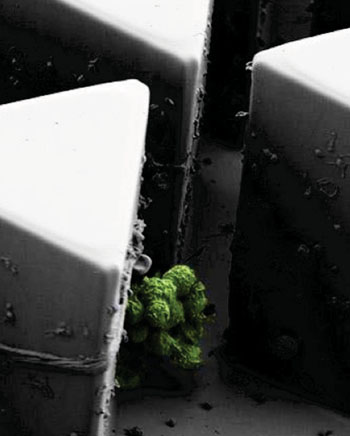Microfluid Chip Traps Migrating Tumor Cell Clusters
By LabMedica International staff writers
Posted on 01 Jun 2015
A microfluidic chip has been developed that can capture rare clusters of circulating tumor cells, which could yield important new insights into how cancer spreads.Posted on 01 Jun 2015
One way cancer spreads from the primary tumor to other parts of the body is when tumor cells break off and travel through the bloodstream and these circulating tumor cells (CTCs) are very rare, and travel either singly or in clusters and the new device can capture these very rare clusters of migrating cancer cells.

Image
Scientists at Massachusetts General Hospital (Boston, MA, USA) and their colleagues used the new chip to capture and analyze CTC clusters from 60 patients with metastatic breast, prostate and melanoma cancers. The chip was designed to slowly push blood through many rows of microscopic triangle-shaped posts. The posts are arranged in such a way that every two posts funnels cells towards the tip of a third post. At the tip, single cells, including blood cells and single CTCs , easily slide to either side of the post and continue through the chip until reaching the next tip; however CTC clusters are left at the tip, hanging in the balance due to forces pulling them down the post in opposite direction.
To determine the efficiency of the device called, Cluster-Chip, the team introduced fluorescently tagged cell clusters, ranging from 2 to 30 cells, into the chip and counted the number of clusters that were captured and the number that flowed through undetected. At a blood flow rate of 2.5 mL/hour, the chip captured 99% of clusters containing four or more cells, 70% of three-cell clusters, and 41% of two-cell clusters. Comparison of the clusters under a microscope before and after capture found that the chip had no negative effects on the integrity of the clusters as a whole.
Roderic I. Pettigrew, PhD, MD, director of the National Institute of Biomedical Imaging and Bioengineering (Bethesda, MD, USA) said, “Given the increasing number of cancer therapies that engage the immune system, the ability to monitor tumor-immune cell interactions via the blood could be of great value. Very little is known about CTC clusters and their role in the progression and metastasis of cancer. This unique technology presents an exciting opportunity to capture these exceptionally rare groups of cells for further analysis in a way that is minimally invasive. This is the kind of breakthrough technology that could have a very large impact on cancer research.” The study was published on May 18, 2015, in the journal Nature Methods.
Related Links:
Massachusetts General Hospital
National Institute of Biomedical Imaging and Bioengineering




 assay.jpg)









